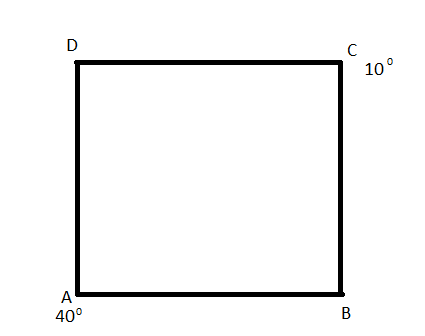
Two diagonally opposite corners of a square loop made of four thin rods of the same material, same dimensions are at temperatures $40^\circ$ and $10^\circ$. If the only heat conduction takes place then the temperature difference between the two other corners will be
$\begin{align}
& \text{A}\text{. 0}{}^\circ \\
& \text{B}\text{. 10}{}^\circ \\
& \text{C}\text{. 25}{}^\circ \\
& \text{D}\text{. 15}{}^\circ \\
\end{align}$
Answer
217.8k+ views
Hint:Heat transfer occurs due to the temperature difference, and heat flows from higher temperature to lower temperature. If two heat conducting materials, having the same dimensions, are made of the same materials, then temperature also decreases at the same rate. Heat always transfers from high temperature to low temperature. The heat conduction formula can be used to calculate the heat transfer rate across two points, where thermal conductivity constant (k) depends on the material used.
Formula used:
Rate of heat conduction (H) through a slab is given by
$H=\dfrac{kA\Delta T}{\Delta x}$
Where,
A is the cross-sectional area of the slab
$\Delta T$ is the temperature difference between two points
$\Delta x$ is the thickness of the slab
K is the proportionality constant, which is called thermal conductivity of the material.
Complete step-by-step answer:
First, we will draw corresponding diagram:

We are asked to find the temperature difference between points B and D, which is $T_B-T_D$.
From the above formula, we can say that heat conduction rate (H) is directly proportional to cross sectional area (A) and temperature difference $\Delta T$, and H is inversely proportional to slab’s thickness $\Delta x$.
The square loop in the above question is made of the same material, and wire having the same dimensions. So $\Delta x$, A and k will not affect calculation and heat will flow at the same rate through all four wires.
Heat flow through path ADC = Heat flow through path ABC
$\Rightarrow {{H}_{1}}={{H}_{2}}$
But rate of heat conduction (H) through a slab is given by $H=\dfrac{kA\Delta T}{\Delta x}$, so the above equation can be written as,
$\dfrac{kA\left( {{T}_{A}}-{{T}_{D}} \right)}{{{x}_{AD}}}=\dfrac{kA\left( {{T}_{A}}-{{T}_{B}} \right)}{{{x}_{AB}}}$
Now we know,
${{x}_{AD}}={{x}_{AB}}$
So, we get
${{T}_{B}}-{{T}_{D}}=0$
Because heat will flow at the same rate through all four wires, heat will reach point B and point D in the same amount of time. Thus, the temperature difference between B and D will be 0.
So, the answer is A.
Note: Conduction means basically transfer of energy, when one part of a material is heated, it gets excited and transfers energy to its nearest particle, which further transmits the heat energy. Thus, heat energy gets transferred from one end to another. Heat conduction only takes place when there is a difference in temperature between two points.
Heat conductivity differs from material to material. Generally, materials with high heat conductivity are used as sink of heat in mechanical machines.
Formula used:
Rate of heat conduction (H) through a slab is given by
$H=\dfrac{kA\Delta T}{\Delta x}$
Where,
A is the cross-sectional area of the slab
$\Delta T$ is the temperature difference between two points
$\Delta x$ is the thickness of the slab
K is the proportionality constant, which is called thermal conductivity of the material.
Complete step-by-step answer:
First, we will draw corresponding diagram:

We are asked to find the temperature difference between points B and D, which is $T_B-T_D$.
From the above formula, we can say that heat conduction rate (H) is directly proportional to cross sectional area (A) and temperature difference $\Delta T$, and H is inversely proportional to slab’s thickness $\Delta x$.
The square loop in the above question is made of the same material, and wire having the same dimensions. So $\Delta x$, A and k will not affect calculation and heat will flow at the same rate through all four wires.
Heat flow through path ADC = Heat flow through path ABC
$\Rightarrow {{H}_{1}}={{H}_{2}}$
But rate of heat conduction (H) through a slab is given by $H=\dfrac{kA\Delta T}{\Delta x}$, so the above equation can be written as,
$\dfrac{kA\left( {{T}_{A}}-{{T}_{D}} \right)}{{{x}_{AD}}}=\dfrac{kA\left( {{T}_{A}}-{{T}_{B}} \right)}{{{x}_{AB}}}$
Now we know,
${{x}_{AD}}={{x}_{AB}}$
So, we get
${{T}_{B}}-{{T}_{D}}=0$
Because heat will flow at the same rate through all four wires, heat will reach point B and point D in the same amount of time. Thus, the temperature difference between B and D will be 0.
So, the answer is A.
Note: Conduction means basically transfer of energy, when one part of a material is heated, it gets excited and transfers energy to its nearest particle, which further transmits the heat energy. Thus, heat energy gets transferred from one end to another. Heat conduction only takes place when there is a difference in temperature between two points.
Heat conductivity differs from material to material. Generally, materials with high heat conductivity are used as sink of heat in mechanical machines.
Recently Updated Pages
Arithmetic, Geometric & Harmonic Progressions Explained

Cartesian Form of Vector Explained: Formula, Examples & Uses

Apparent Frequency Explained: Formula, Uses & Examples

Calorimetry: Definition, Principles & Calculations

Centrifugal Force Explained: Definition, Formula & Examples

Charge in a Magnetic Field: Definition, Formula & Examples

Trending doubts
JEE Main 2026: Application Form Open, Exam Dates, Syllabus, Eligibility & Question Papers

Derivation of Equation of Trajectory Explained for Students

Hybridisation in Chemistry – Concept, Types & Applications

Understanding the Angle of Deviation in a Prism

Understanding Collisions: Types and Examples for Students

How to Convert a Galvanometer into an Ammeter or Voltmeter

Other Pages
JEE Advanced Marks vs Ranks 2025: Understanding Category-wise Qualifying Marks and Previous Year Cut-offs

Units And Measurements Class 11 Physics Chapter 1 CBSE Notes - 2025-26

NCERT Solutions For Class 11 Physics Chapter 8 Mechanical Properties Of Solids

Motion in a Straight Line Class 11 Physics Chapter 2 CBSE Notes - 2025-26

NCERT Solutions for Class 11 Physics Chapter 7 Gravitation 2025-26

Understanding Atomic Structure for Beginners




